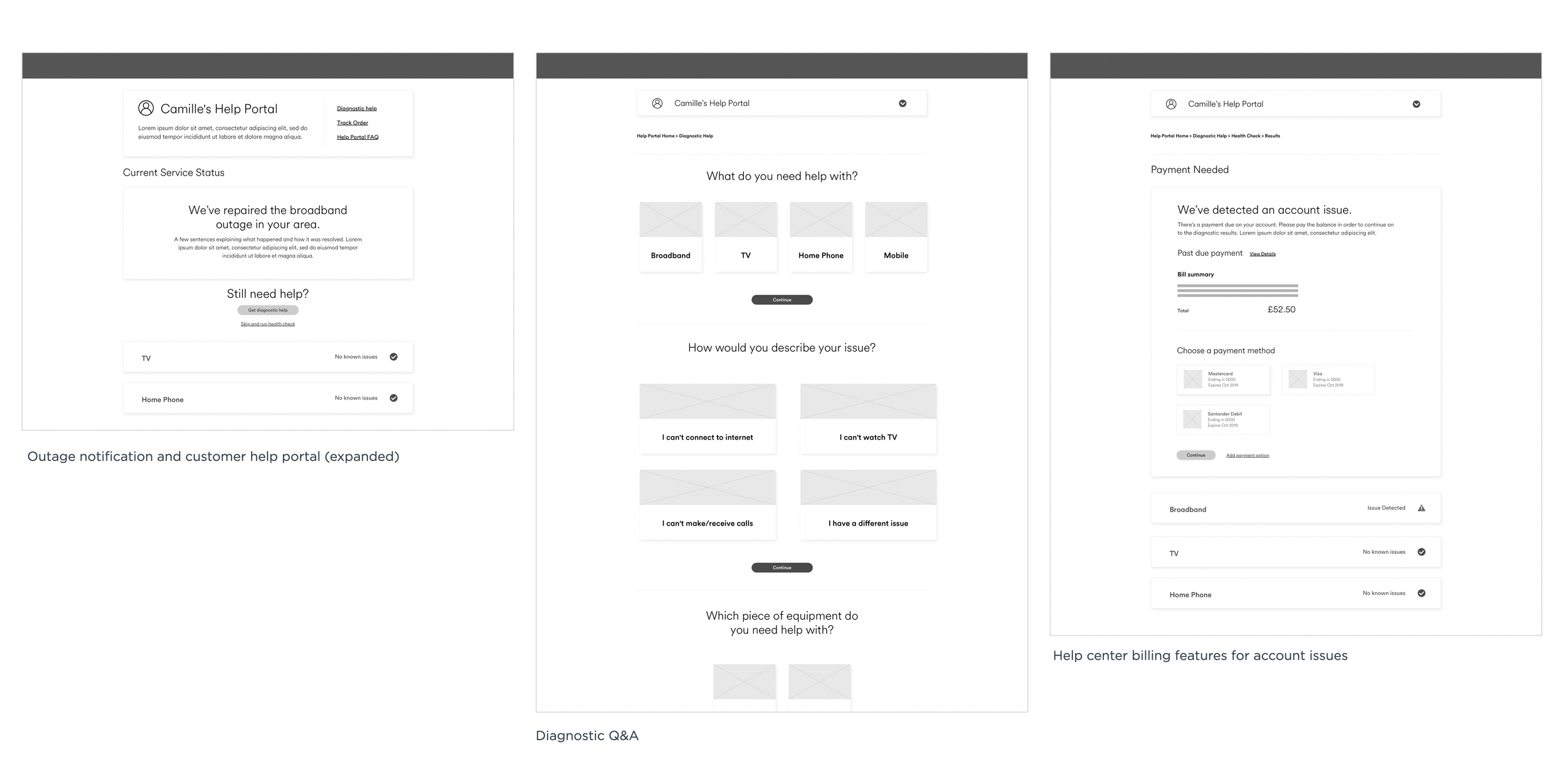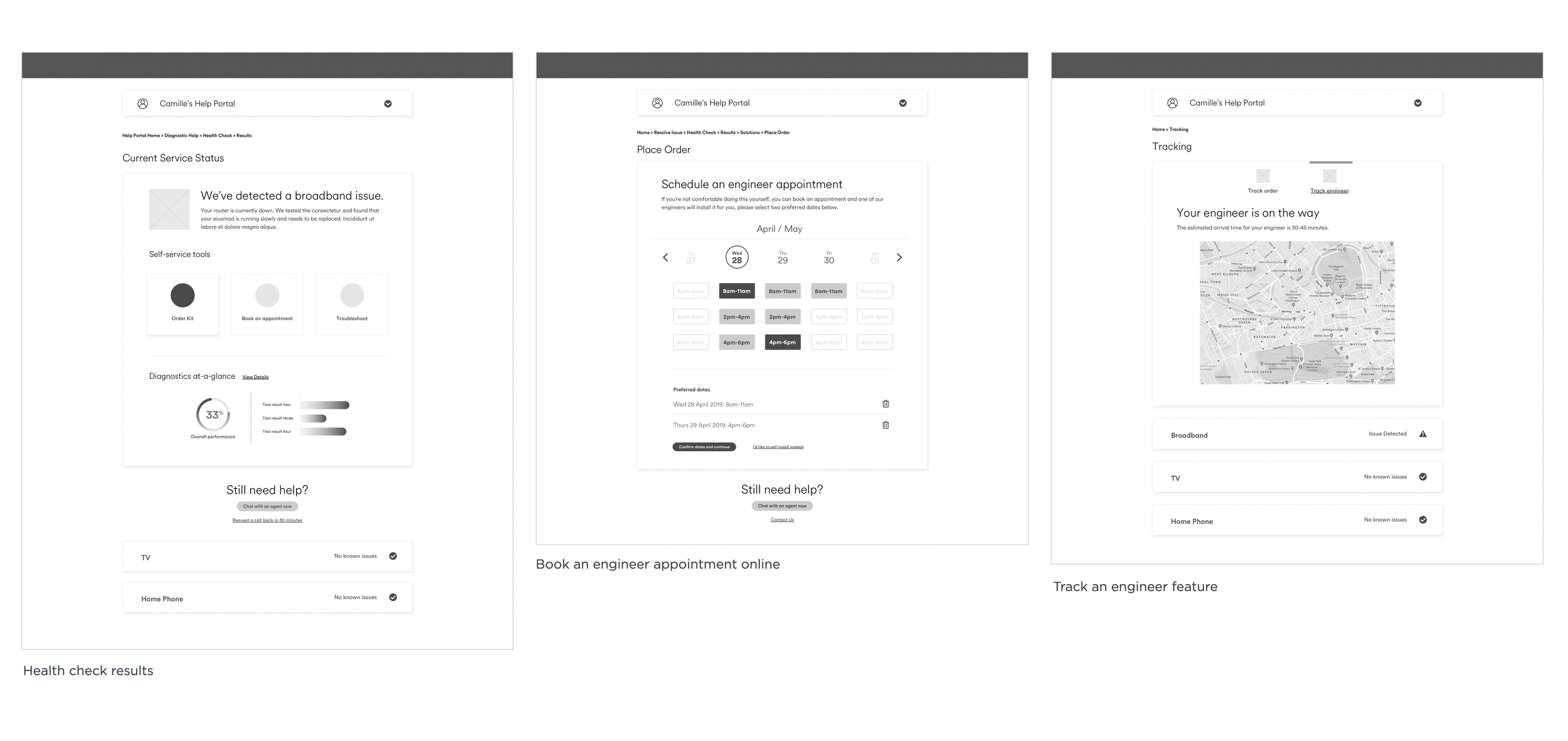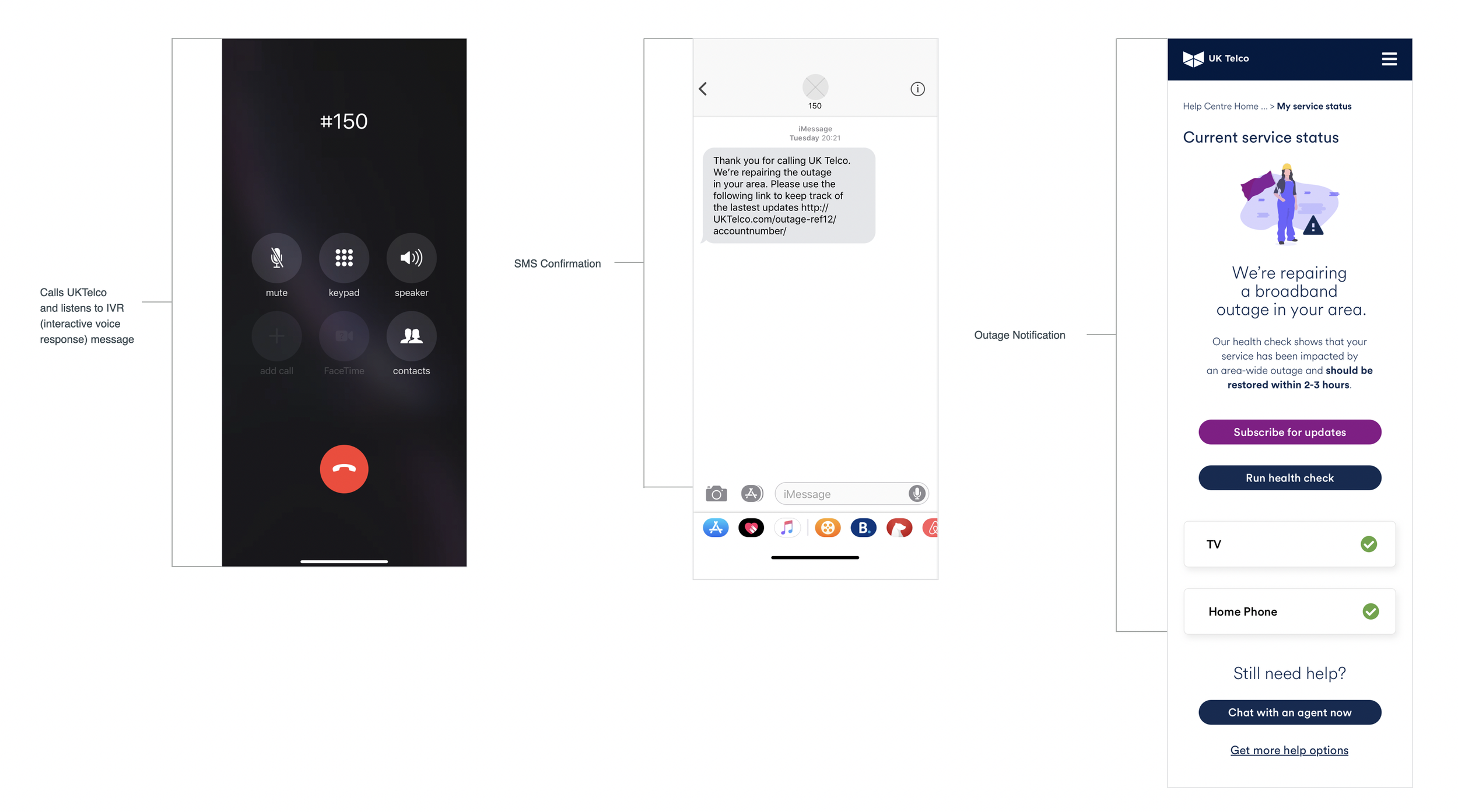Omnichannel Support for a UK Broadband Provider
UKTelco* is a multinational, B2C telecommunications company based in England. I partnered with Bain & Company to redesign UKTelco’s broadband self-service experience. My role spanned discovery research, UX strategy, and workshop facilitation, as well as MVP feature prioritization, usability testing, and end-to-end design.
*To respect Bain and Company’s relationship with the client, I’ve sanitized this project to remove any explicit client references. This includes company names, content, branding, UI, etc.
OBJECTIVE
Reduce support costs and improve customer retention by increasing adoption of digital self-service over costly offline channels.
PROBLEM
UKTelco’s help site was outdated and inefficient. Customers lacked confidence in digital support, defaulting to call centers and field visits. This “calling habit” drove up costs, created unnecessary truck rolls, and weakened customer satisfaction and retention.
HYPOTHESIS
Equipping customers with backend diagnostics, real-time outage notifications, and personalized multi-format help would increase trust in digital support, resolve issues faster, and break the “calling habit” — ultimately reducing call-center costs and unnecessary engineer dispatches.
USERS
Digital-first users
Wanted a one-and-done troubleshooting experience with minimal effort and clear next steps.
Hybrid users
Needed actionable help across multiple formats (video, images, text).
Phone-first users
Expected human, clear, and efficient support, plus reassurance post-call that issues were fully resolved.
APPROACH
• Conducted discovery research and mapped the end-to-end help journey to surface pain points, which informed the design of outage notifications and guided diagnostics.
• Facilitated a day-long design workshop in Manchester with stakeholders across strategy, engineering, design, CX, and maintenance, which shaped the vision for multi-format help content and digital-first support.
• Partnered with client PMs and engineers to test feasibility of backend diagnostics, SMS notifications, and online scheduling, which enabled the rollout of these features.
• Defined quick wins while aligning stakeholders on long-term scalability, prioritizing outage notifications and engineer booking for immediate impact.
SOLUTIONS
• Rolled out real-time outage notifications via SMS and web, giving customers proactive visibility into service status.
• Developed personas (digital-first, hybrid, phone-first) and designed guided diagnostic flows tailored to their needs, helping customers identify and contain issues without escalation.
• Enabled online engineer booking and tracking, reducing reliance on phone scheduling.
• Expanded the help site with personalized, multi-format content (video, images, text) to support different learning preferences.
RESULTS
• Frequency: 84% of customers experiencing an outage opted into SMS updates.
• Adoption: 57% increase in web self-service adoption.
• Duration: Online self-service resolution time decreased by 27%.
• Containment: 87.5% of engineer visits were booked online, with 22% reclaimed due to proactive outage SMS
TAKEAWAYS
• Patience was key to building client trust and collaborating across siloed engineering teams
• Proactive communication (SMS + web notifications) rebuilt customer trust in digital channels.
• Guided diagnostics effectively contained issues online and reduced unnecessary escalations.
• Personalization opportunities remain: tailored help content could further boost digital adoption and customer confidence.
CUSTOMER INTERVIEWS
I partnered with product to plan, organize, and lead a day-long design workshop. Stakeholders across strategy, engineering, product design, customer experience, and maintenance came together during a day long design workshop to understand the problem, get acquainted with the fact base, and brainstorm solutions.
PERSONAS
Coming out of the interviews we arrived three high level personas–categorized by their preferred help method–digital first, phone-first, and a hybrid user. The personas covered a range income, age, family status, and lifestyle preferences.
CUSTOMER JOURNEY
The interviews also gave us a much better understanding of the as-is customer journey. It became clear that getting technical help was convoluted multistep process that could take anywhere from a few minutes to several days to resolve.
DISCOVERY WORKSHOP
I partnered with product to plan, organize, and lead a day-long design workshop. Stakeholders across strategy, engineering, product design, customer experience, and maintenance came together during a day long design workshop to understand the problem, get acquainted with the fact base, and brainstorm solutions.
USABILITY TESTING
From left to right: We tested several features, including — Screen 1: a dedicated help portal; Screen 2: a diagnostic Q&A tool to quickly route users to the right solution; Screen 3: embedded payment options for resolving billing issues within the help center; Screen 4: a health check feature with diagnostic results to guide troubleshooting; Screen 5: online booking for engineer appointments; and Screen 6: real-time tracking to reduce wait times for scheduled engineer visits.
MVP PROTOTYPE (UNBRANDED)
This flow explores what happens when a customer has two service issues at the same time. The first issue is a lack of service due to an area wide outage. The second technical issue is due to an in-home equipment fault. The customers wifi router has an expired warranty. The customer will run a health check to quickly identify the cause of a service interruption–billing issues, area wide outages, and known issues with equipment (e.g., expired warranty).
From L to R: Left - Customer dials into call center gets pre-recorded message alerting them that there’s an outage in their area; they’re then prompted to opt-in to SMS notifications or to continue holding; Middle - Customer opts-in to SMS notifications and receives a token link that logs them into the UKTelco help site; Right - User sees the current service status (a broadband outage) on the default screen alongside status information for TV and Home Phone
From L to R: Left - User selects delivery preferences– e.g., replacement router delivered via mail or via click and collect; Middle - User confirms or edit delivery address (for mail); Right - User confirms quantity and places order. User has the option to purchase add-ons.
From L to R: Left - User gets confirmation that order has been placed; Middle - User can track the order or review installation instructions prior to delivery; and Right - User receives an NPS survey after the router has been delivered and successfully installed.
Company: Bain and Company Timeline: 6 weeks Role: Senior UXR and UX Designer Contributors: Marcus Wacker (Design Director), Martin Goette (Engineering Manager), George Lolos (Staff Software Engineer), Clay Wertheimer (Senior Consultant), and Rio Richardson (Associate Consultant)








